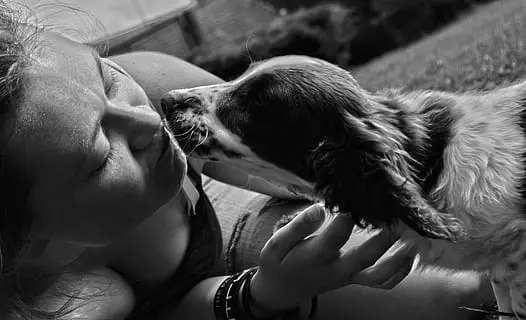Are Frenchies hypoallergenic?
I wondered about this when I found out that my Aunt June was coming over for a weekend visit.
You see, she happens to be severely allergic to dogs and while I did not want her to suffer, I also did not want to board my Frenchie.
So I started my investigation about whether Frenchies are hypoallergenic dog breeds (unfortunately they aren’t!) and also about the very meaning of the word ‘hypoallergenic’ and which dog breeds fit that category.
I have covered all this information in this guide along with the main differences between hypoallergenic and non-hypoallergenic dogs.
Later on, I have also covered some useful tips that can help you manage pet allergy symptoms when there is a non-hypoallergenic dog like a Frenchie – around you.
(I used the same tips to make my aunt’s stay more comfortable and it worked pretty well!)
What Does Hypoallergenic Mean?

The word hypoallergenic means ‘that which is less likely to trigger an allergic reaction in an individual.’
There are many dog breeds that are hypoallergenic which makes them suitable for households having individuals who develop allergy symptoms when they are near non-hypoallergenic dogs. These symptoms typically include:
- Runny, watery, red, or itchy eyes
- Nasal congestion
- Runny nose
- Sneezing
- Itchy skin
- Facial swelling
- Cough
- Fever
An individual allergic to pets could develop these symptoms in varying degrees and they often worsen during their pet’s annual shedding season.
Some individuals are allergic only to dogs, others to cats, while still others, to all domestic animals.
Most people think that allergies are caused by the animal’s fur.
In reality, allergies are triggered by proteins which, in turn, are secreted by the animal’s oil glands and are shed along with hair and dander (or dead skin cells).
You also find these allergens/proteins in the dog’s saliva and urine.
Therefore, when we say someone is allergic to dogs, it means that they are reacting to the dog’s saliva, dander, or urine.
Nearly tens of millions of people across the world suffer from allergies.
According to the Asthma and Allergy Foundation of America, the United States alone has 50 million allergy sufferers. And one out of these five happen to be allergic to dogs.
Are Frenchies Hypoallergenic?

Unfortunately, French bulldogs are not hypoallergenic.
They shed their fur and while their short tight coats are characterized by tiny hairs, they still shed considerably all-year round.
Unlike the more hairy dog breeds, you might not exactly see a lot of pet-hair all around, but it is very much there.
As explained earlier, most people allergic to dogs are actually allergic to ‘dander’ on dog’s skin. And Frenchies do shed and leave dander all over.
Dander can be compared to human dandruff. It is tiny, whitish, flaky, and similar to dead skin. It may not be visible to the naked eye but it is very much present all over the furniture, carpets, beds, clothing, etc. in homes with pets.
Did you know that there are nearly 14 different types of French bulldog varieties?
These include Fawn Frenchie, Brindle frenchie, Pied Frenchie, Black Frenchie, White Frenchie, and so on.
Unfortunately, none of them are hypoallergenic.
So Which Dog Breeds are Hypoallergenic?

To be honest, no dog breed can be 100% hypoallergenic as they all shed to some extent.
However, breeders have selectively bred certain dog breeds to create less-shedding or even non-shedding dogs which has made lives so much better for allergic dog lovers.
There are several pure breed dogs that are hypoallergenic and they include:
- Poodles
- Bichon Frise
- Samoyeds
- Xoloitzcuintli
- Yorkshire Terrier
- Shih Tzu
- Portuguese Water Dog
- Brussels Griffon
- Schnauzer
- Italian Greyhound
- Basenji
Similarly, there are several crossbreeds that are hypoallergenic:
- Shih Poo
- Cavapoo
- Cockapoo
- Maltipoo
- Labradoodle
Please note that there is NO CAST IRON Guarantee that an allergy sufferer won’t have an allergic reaction to the above mentioned hypoallergenic dog breeds.
However, if you choose a hypoallergenic dog breed, then your chances of developing allergy symptoms will be greatly reduced.
So the bottom-line is:
- No dog is 100% hypoallergenic
- No dog is 100% non-shedding.
Which also brings us to three other important points:
- People’s pet allergies vary greatly.
- Pet allergy sufferers might react differently to different breeds as well as individual dogs within the same breed.
- An allergy sufferer might be fine with one puppy but could still have a reaction to another puppy from the same litter.
Main Differences between Hypoallergenic and Non-hypoallergenic Dog Breeds

Even though the differences between hypoallergenic and non-hypoallergenic dog breeds are not huge, they are enough to reduce the allergy attacks some people tend to experience when they are around certain breeds.
For example, if you are severely allergic, then you might not even be able to be in the same room as a dog for long periods of time. This can be extremely frustrating.
It worth mentioning here that your Frenchie will want to be in the same room as you as it is prone to separation anxiety and is a Velcro Dog Breed.
So, if you are yet to get home your Frenchie, you might want to rethink the decision and it may be best to go in for one of the hypoallergenic dog breeds listed above especially if you have severe dog allergy symptoms.
Here are the differences between hypoallergenic and hypoallergenic dogs like Frenchies:
| Hypoallergenic | Non-hypoallergenic |
| They do not shed too much. Some are completely non-shedding. | Non-hypoallergenic dogs shed a lot, sometimes they shed heavily twice a year. |
| They are typically single coated or short-coated dogs. Some breeds like Yorkies have human-like or silky hair which does not shed too much. Many are also hairless, like the Xoloitzcuintuli. | They have a thick undercoat which is what sheds annually or bi-annually. It also traps dander and dirt aggravating allergies in humans. |
| Hypoallergenic dogs’ skin is more or less free from dander | Non-hypoallergenic dogs produce a lot of dander |
| They do not salivate a lot which means that when they clean their paws and their coat, you can cuddle with them as their saliva will not harm you if you happen to be allergic. | These dogs salivate and drool. The saliva can also trigger allergies. If your pet grooms and licks itself, the saliva will be present all over its coat and skin which could trigger allergies when you pet it. |
Top 10 Tips for Reducing Pet Allergens when Living with a Frenchie

Here are some tips to live with a Frenchie when you have dog allergies:
1. Keep your pet out of the bedroom
Use baby gates or keep doors closed and restrict your Frenchie’s entry in your bedroom. Avoid having him/her sleep on the couch. Limit your pet to one part of the house to contain allergens.
2. Use protective covers and wash them often
If you allow your Frenchie on the sofa/couch, in the car, on the seats, beds, etc. then use covers for them.
You can get duvet covers, bed sheets, sofa and car seat covers to protect your furniture from pet hair. But you must also make it a point to wash those covers 1-2 times a week. This will greatly reduce dander and allergens.
3. Groom your buddy at regular intervals
Brush your Frenchie using a slicker brush. Always perform the brushing activity outdoors to prevent dander from coming indoors.
Bathing your Frenchie once a month can also considerably reduce shedding and dander to minimize allergens.
Also Read: Best French Bulldog Shampoo
4. Wash pet bedding frequently
Clean your pet’s bed using a mild detergent. If the fabric can withstand bleach, then use it. Bleach will eliminate allergens and mites.
Also Read: Best Dog Beds for French Bulldogs
5. Use a HEPA air purifier/vacuum cleaner
A HEPA (High Efficiency Particle Air) purifier can remove nearly 99.99% of particles from the surrounding air and that includes pet dander as well. This is known to give much-needed relief to allergy sufferers.
You can also invest in a HEPA Filter Vacuum.
Both HEPA air purifier and vacuum with HEPA filter can be very expensive but if you want to keep a Frenchie in your home while suffering from pet allergies, then it is really worth the price.
6. Clean your entire house regularly
Regardless of whether or not you use a HEPA-based vacuum cleaner, you need to dust and mop your entire house regularly. This will considerably reduce allergens and dander in the environment.
7. Feed your Frenchie a coat and skin supplement
It is important to keep your Frenchie’s skin and coat supply and moisturized. This could help reduce and prevent unseasonal shedding and dander.
Supplements containing Omega-3 essential fatty acids or fish oil are known to help benefit Frenchies by reducing skin problems like dryness, scabbing, itching etc.
8. Use dander removing spray
Spray your furniture and your pet with a dander-reducing spray like Allerpet.
It considerably reduces saliva and dander from your pet’s fur and is 100% safe, vet-approved, and non-toxic.
9. Avoid touching other dogs
There’s no point in taking all the above precautions if you are going to pet other dogs. If contact occurs, wash your hands right away.
10. Consider medication
Discuss latest allergy-reducing medicines, immunotherapies, sprays, and tablets with your doctor. They can tell you about the latest innovations in the field of allergy medicines.
Tips for Buying your Frenchie if You are an Allergy Sufferer

This section is for people with pet allergies who are yet to buy/adopt their Frenchie.
1. Spend time with your potential pet before you bring it home
If you have your heart set on a Frenchie pup, please spend time with it. Visit it several times at the breeder’s/shelter.
Handle the dog, rub your face, and if possible, even lick your hands after you have touched it. Allow the pup to lick you as well. This will help you ‘absorb’ as much of the allergen as possible.
Visit your Frenchie several times before you make the life-long commitment.
2. Perform the t-shirt/towel test
This involves rubbing the t-shirt or towel on the puppy’s skin and taking it home. Sniff it, handle it, wear it, and see if you have a delayed reaction.
3. Be honest with the breeder
Explain to the breeder about possible allergies. Speak to him/her about returning the puppy if an allergic reaction does occur.
(Do not expect the breeder to take your pet back if you develop allergies once your Frenchie is an adult).
FAQs on Are Frenchies Hypoallergenic?

1. Are Frenchies bad for allergies?
Since Frenchies shed all-year round, they are not the most suitable pets for allergy sufferers.
Also, their sensitive skin is susceptible to dryness which can cause itching, paw-licking, etc. They are also known to drool. All these can lead to allergens and dander in your environment.
2. Do Frenchies shed a lot?
Normally, French bulldogs are moderate shedders.
They shed bit-by-bit all-year round. If excess shedding occurs and results in patchy hair-loss, then your pet might be having an underlying health issue, parasites, food allergies, stress, or hormonal imbalance.
3. Are Frenchies prone to skin allergies?
Yes. French bulldogs have an extremely sensitive skin and it is prone to dryness, itching, hotspots, etc.
This can further worsen due to poor diet, stress, environmental allergens, and so on. You might see your pet scratch its folds of skin, ears, lick its paws, rub its back against a surface, or itch uncontrollably.
4. Can I cuddle my Frenchie if I have allergies?
People with allergies should ideally minimize contact with their Frenchie because they aren’t a hypoallergenic dog breed.
If you do cuddle your Frenchie, make sure you have brushed or bathed it first. Also, change your clothes, wash your hands, and/or take a bath immediately afterwards to reduce dander on your clothes and skin.
Conclusion – Are Frenchies Hypoallergenic?
Are Frenchies hypoallergenic? No. Frenchies are not hypoallergenic.
However, even the so-called hypoallergenic dogs aren’t 100% hypoallergenic as they still shed and produce dander, saliva, and urine.
If you are allergic but have decided to still get a Frenchie, you can do several things to reduce allergic reactions.
This includes cleaning your pet’s skin-folds, using a HEPA-filter vacuum/purifier, and washing your hands frequently or bathing several times a day.
We hope this guide helps you manage your allergy symptoms as it did for my dear Aunt June!






